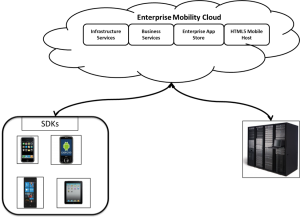 By Jesus Rodriguez, Tellago, Inc and Tellago Studios, Inc
By Jesus Rodriguez, Tellago, Inc and Tellago Studios, Inc
Enterprise mobility is, arguably, the most important trend in today’s enterprise IT. The ability to enable enterprise business capabilities through mobile devices is an essential element of the modern enterprise. Almost ironically, despite being a technology trend called to modernize the traditional enterprise, most companies have been approaching enterprise mobility using very archaic models.
Let me try to explain.
With some isolated technical exceptions, most enterprise mobility platforms in the market can be seen as a slightly more moderns models of Research in Motion’s (RIM) enterprise platform. To put it in simple terms, using an enterprise mobility platform today is like using Blackberry Enterprise Server for your IPhone.
Why Do We Say This?
The current enterprise mobility platform landscape is filled with technologies that resemble the following model.
- An On-Premise Enterprise Mobility Server: A server side infrastructure that sits in your corporate network and is responsible for controlling aspects such as device management, cloud security capabilities, integration to line of business systems among other essential capabilities of an enterprise mobility infrastructure. What this means is that organizations need to invest in on-premise hardware and software infrastructures to enable any basic enterprise mobility experience.
- A Mobile Device Manager: A traditional and somewhat overrated element of any enterprise mobility infrastructure, the MDM layer is responsible for controlling the management and provisioning of mobile devices. What this essentially means is that organizations focus on managing the devices instead of managing the specific users and mobile applications.
- A Proprietary Developer Framework: Traditional enterprise mobility platforms typically include proprietary development tools and frameworks to implement applications that can leverage the capabilities of the platform. What this essentially means is that developers can’t take advantage of the top mobile development platforms such as IOs, Android and Windows Phone SDKs, PhoneGap, AppAccelerator, Sencha or many others.
As a result of embracing the aforementioned model, enterprise mobility has become an incredibly complex and highly expensive effort that requires the use of proprietary technologies, which comes with the required army of trainers, consultants and major upgrade fees. Even more importantly, given its high cost in infrastructure, resources and time, enterprise mobility has become a privilege of large companies leaving most medium business struggling to find a successful path to enable a cohesive mobile infrastructure.
I personally can’t avoid finding the whole enterprise mobility technology ecosystem very ironic. If you think about it, mobile computing is supposed to bring fresh waves of innovation to the enterprise software ecosystem and yet we keep using the same old-school archaic mechanisms when it comes to implementing it in the enterprise.
A Cloudy Path to Enterprise Mobility
During the last few years, cloud computing has disrupted some of the fundamental building blocks of enterprise software. Whether we are thinking of infrastructure, software or platform as a service, cloud computing models share the same underlying principle of enabling a self-managing, elastically scalable computing model that removes the complexities of the equivalent on-premise models.
It sounds like a perfect solution for enterprise mobility, doesn’t it?
We believe cloud computing models can offer an innovative solution to the challenges of enterprise mobility solutions. The maximum expression of these solutions is what we call the enterprise mobility cloud.
A Heroku For Your Enterprise Mobile Apps
A few years ago, Heroku disrupted the software application world by providing a complete cloud based model to the software application development lifecycle. The Heroku mantra was based on a very simple model that enables developers to build applications using their favorite technologies without the need to invest in any on-premise infrastructure. Followed by technologies such as Windows Azure, VMWare’s Cloud Foundry or DotCloud, Heroku pioneered a new cloud computing dimension that we know today as Platform as a Service (PaaS).
Let’s imagine a world in which you can develop your enterprise mobile applications using your favorite frameworks, IOS, Android, PhoneGap without the need of using any proprietary technology. Let’s image that your applications can seamlessly authenticate to the corporate network, exchange data securely and interact with other enterprise services. Imagine you can register and provision your applications using a corporate application store. Finally, image you can accomplish all this without the need of any enterprise infrastructure.
Doesn’t this sound like a Heroku for your enterprise mobile applications? Well, welcome to the Enterprise Mobility Cloud.
The main goal of an enterprise mobility cloud is to enable the necessary infrastructure and platform components to provide enterprise ready capabilities to your mobile applications. The following figure illustrates this model.
At a high level, we can identify the following fundamental components of an enterprise mobility cloud.
- Infrastructure Services: These services will enable capabilities such as active directory authentication, authorization, data exchange, messaging among other essential infrastructure of any enterprise mobile applications.
- HTML5 hosting: An enterprise mobility cloud should be able to host, manage and scale HTML5 mobile websites.
- Business Services: These services expose business-centric capabilities such as order tracking, contact management, etc that will be consumed by different mobile applications.
- Enterprise App Store: An essential component of an enterprise mobility experience, this app store will serve as the main repository to catalog, manage and maintain the different mobile applications used in your enterprise.
- Mobile SDKs: Providing SDKs for the most popular mobile development platforms will provide developers will a low-level entry point to start embracing the enterprise mobility cloud experience.
Conclusion
For years, we have been approaching enterprise mobility using the same old principles of the RIM enterprise school. In order to change this, we need to apply the same disruptive principles that PaaS technologies like Heroku brought to the software development lifecycle years ago. We believe an enterprise mobility experience powered by cloud computing models will lower the barrier and remove the friction to start embracing mobile applications in the enterprise.
Jesus is a co-founder and CEO of both Tellago Studios and Tellago, two fast growing start-ups with a unique vision around software technology. Jesus spends his days working on the technology and strategic vision of both companies. Under his leadership, Tellago and Tellago Studios have been recognized as an innovator in the areas of enterprise software and solutions achieving important awards like the Stevie Awards’ American and International Business Awards.
A software scientist by background, Jesus is an internationally recognized speaker and author with contributions that include hundreds of articles and sessions at industry conferences. Jesus serves as an advisor to several software companies such as Microsoft and Oracle, and is the only person who currently holds both the Microsoft MVP and Oracle ACE technology awards. Jesus is a prolific blogger on all subjects related to software technology and entrepreneurship. You can gain valuable insight on business and software technology through his blogs at http://jrodthoughts.com and http://weblogs.asp.net/gsusx .
